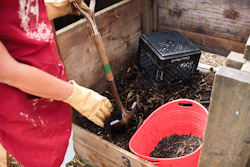Improve Your Soil With Compost

Any type of soil benefits from compost. Not only does it have nutrients that improve soil fertility and help plants grow strong and healthy, compost increases water retention in your soil so you don’t have to water as often. Adding compost will save money on your water bill and you can make it in your own backyard for free. Instead of sending your yard trimmings off to the landfill every week, you can turn these recyclable organic materials into rich compost for use in your garden.
You don’t need a lot of space to compost. You just need an area that is about 3 feet by 3 feet by 3 feet. Locate your pile in partial shade, so that it does not dry out the composting materials too quickly. Leave some room around the pile so that you will have an area to turn your compost easily.
Compost bins help keep the materials contained during the process. They also deter pests from digging in your pile and help it to retain heat and moisture. You can make a bin at home or purchase a commercial one.
The basic recipe for making finished compost is to combine four basic ingredients: Greens, Browns, Water and Air. Mix all ingredients together and let it “cook” allowing nature’s helpers (microbes and insects) to assist. In as little as 3 months you could have nutrient-rich compost for your garden!
- Greens include grass clippings, green leaves, fresh shrub prunings, fruit and vegetable scraps and tea bags and coffee grounds. Don’t add any meat or dairy products.
- Browns include dried materials like dead leaves, dried twigs, paper and sawdust. They work best when shredded or chopped.
Half of your compost pile should be Greens and half should be Browns.
- Water is necessary to create an environment that is favorable to the microorganisms that break down organic materials. Keep your compost pile moist as a wrung out sponge.
- Air is also necessary for the microorganisms. Turn your compost every few days.
Your compost is ready when it has a pleasant earthy aroma and a dark brown color with a crumbly texture. You should not be able to recognize any of the materials originally placed in the bin. There may be a few large chunks of woody material which can be screen out and added to your next batch of compost.
Spread 2-4 inches of compost over the soil and mix with the soil to a depth of approximately 6 inches.
Further Reading:

